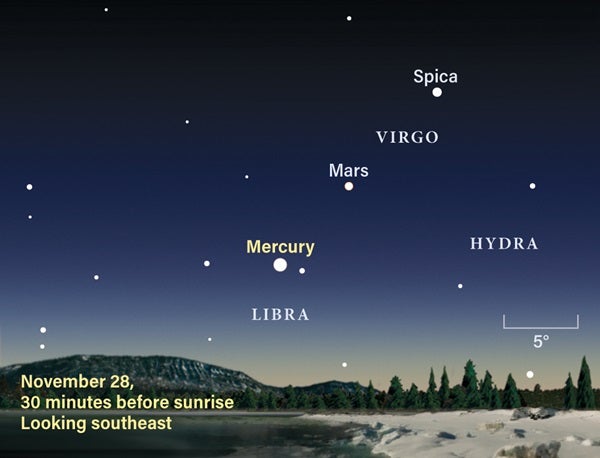A lone bright star now hangs low in the south during the early evening hours. First-magnitude Fomalhaut — often called “the Solitary One” — belongs to the constellation Piscis Austrinus the Southern Fish. From mid-northern latitudes, it climbs 20° above the horizon at its best. How solitary is Fomalhaut? The nearest 1st-magnitude star to it, Achernar at the southern end of Eridanus the River, lies some 40° away.
Saturday, November 23
Venus’ relentless push higher into the early evening sky coupled with Jupiter’s inexorable fall brings the brilliant planets together after sunset tonight and tomorrow night. The gap between the two worlds stands at 1.5° both evenings — tonight, Jupiter lies above Venus; tomorrow night, Venus appears to the left and slightly below its partner. The best views of this magnificent conjunction will come with the naked eye or binoculars. A telescope at low power can just capture the two in a single field, but the pair’s low altitude means you likely won’t see much detail on either planet.
The Moon reaches perigee, the closest point in its orbit around Earth, at 2:41 a.m. EST. It then lies 227,867 miles (366,716 kilometers) away from us.
The waning crescent Moon makes a convenient guide for spotting Mars this morning. Look for the 6-percent-lit Moon about 15° high in the east-southeast an hour before sunrise. The Red Planet lurks 4° to Luna’s right. Although magnitude 1.7 Mars won’t look prominent, you shouldn’t have any trouble seeing it. And while you’re braving the predawn chill, you should also look for magnitude –0.4 Mercury 8° below the Moon.
Monday, November 25
Although the Leonid meteor shower peaked before dawn November 18, observing conditions have improved significantly since then. The gibbous Moon of last week has now waned to a thin crescent that doesn’t interfere with viewing a few last-minute stragglers. To tell a Leonid meteor from a sporadic, trace the shooting star’s path backward. If it points toward the constellation Leo the Lion, it likely is a shower member.
Tuesday, November 26
New Moon occurs at 10:06 a.m. EST. At its New phase, the Moon crosses the sky with the Sun and so remains hidden in our star’s glare.
Wednesday, November 27
Neptune’s westward motion against the background stars comes to a halt today. The distant planet appears highest in the south near the end of evening twilight and doesn’t set until around midnight local time. The magnitude 7.9 world lies in Aquarius, 1.5° west-southwest of the 4th-magnitude star Phi (φ) Aquarii. You’ll need binoculars to spy Neptune and a telescope to see its blue-gray disk, which spans 2.3″.
Although the Moon passed between the Sun and Earth just two days ago, its rapid orbital motion has already brought it back into view low in the southwest shortly after sunset. As a bonus, the slender crescent appears against the azure twilight in the company of Venus and Jupiter. You can find brilliant Venus 2° below the Moon and dimmer Jupiter 6° to Luna’s lower right.
Mercury is now in the midst of its finest morning apparition of 2019. The planet reaches greatest elongation from the Sun today, lying 20° west of our star and appearing 10° high in the east-southeast 45 minutes before sunrise. Mercury maintains this altitude for the next two days. The inner world shines at magnitude –0.6, which is easily bright enough to see with your naked eye, though binoculars will help you pick it out of the twilight glow. When viewed through a telescope, Mercury’s 7″-diameter disk appears slightly more than half-lit.
Friday, November 29
The waxing crescent Moon appears 2° to Saturn’s left this evening. The two stand some 15° above the southwestern horizon an hour after sunset and will make a pretty pair with the naked eye or through binoculars. Of course, Saturn makes a tempting target any night this week. The ringed world shines at magnitude 0.6, more than a full magnitude brighter than any of the background stars in its host constellation, Sagittarius. The best views come through a telescope, however, which reveals a 15″-diameter globe surrounded by a spectacular ring system that spans 35″ and tilts 24° to our line of sight.
Although Thanksgiving weekend signifies autumn to many people, the stars of both summer and winter appear prominent in late November’s evening sky. If you head out around 9 p.m. local time and look toward the west, you’ll see the bright stars of the Summer Triangle. These three luminaries — Vega, Deneb, and Altair — stand out nicely. Deneb appears highest (nearly halfway to the zenith), while the brightest, Vega, lies lower in the northwest. Now, if you turn around and face east, you’ll find stars normally associated with winter. Betelgeuse, Rigel, Aldebaran, and Capella all clear the horizon before 8 p.m. and appear conspicuous an hour later.
Saturday, November 30
While the stars of summer and winter remain on view these late November evenings, the stars of spring are not so lucky. The Big Dipper swings low in the north at this time of year. Although this conspicuous asterism never sets from much of the United States and Canada, it does come close. And the star at the end of the handle — magnitude 1.9 Eta (η) Ursae Majoris — does dip below the horizon around 9 p.m. local time for viewers south of 40° north latitude.
Sunday, December 1
The variable star Algol in Perseus appears faintest at 1:29 a.m. EST tomorrow morning, when it shines at magnitude 3.4. If you start watching it immediately after darkness falls, you can see it dim from its peak brightness (magnitude 2.1) to minimum and then rise back to maximum all in a single night. This eclipsing binary star runs through a cycle from minimum to maximum and back every 2.87 days, but the drop from peak brightness and subsequent rise lasts only about 10 hours. Algol appears in the northeastern sky after sunset and passes nearly overhead around 10 p.m. local time.












